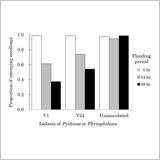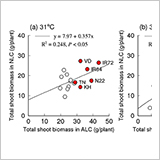Crop Physiology
Genetic Variations in Dry Matter Production, Nitrogen Uptake, and Nitrogen Use Efficiency in the AA Genome Oryza Species Grown under Different Nitrogen Conditions
N. Hamaoka, Y. Uchida, M. Tomita, E. Kumagai, T. Araki and O. Ueno
- In all Oryza plants examined, nitrogen use efficiency (NUE) was higher in low-nitrogen (LN) than in standard-nitrogen (SN) condition, and was conspicuously high in most wild Oryza species and O. glaberrima.
- Under the LN condition, the cultivars and strains with a high NUE showed higher root dry weight, root surface area and bleeding rate and tended to increase capacity of NO3-N uptake.
- This study revealed the presence of superior wild Oryza strains for growth under LN that may be a promising genetic resource for low nitrogen-input agriculture.
Abstract Full Text PDF[795K] |
 |
Tissue Localization of the Glycine Betaine Biosynthetic Enzymes in Barley Leaves
S. Mitsuya, K. Kozaki and T. Takabe
- Tissue localization of two glycine betaine biosynthetic enzymes in barley leaves was examined.
- The expression of BADH and CMO proteins was increased by salinity in the leaves but not in the roots.
- CMO and BADH proteins were constitutively co-localized in mesophyll and bundle sheath cells.
Abstract Full Text PDF[6519K] |
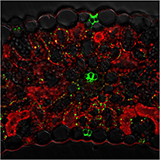 |
Genetic Resources Evaluation
Genotypic Adaptation of Soybean to Late Sowing in Southwestern Japan
Fatichin, S.-H. Zheng, K. Narasaki and S. Arima
- The adaptability of soybean to late sowing, which is an option to avoid damage caused by excess soil moisture, was investigated using 15 genotypes from 6 countries.
- Late sowing reduced the seed yield by 28.1% and 21.8% on average in the 2009 and 2011 experiments, whereas it had almost no effect in 2010.
- The seed yield in late sowing could be improved by the selection of adaptive genotypes that have larger seed numbers and/or longer seed filling periods.
Abstract Full Text PDF[732K] |
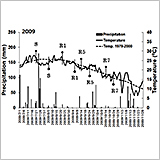 |
Post Harvest Physiology
Validation of QTLs for Eating Quality of Japonica Rice‘Koshihikari’Using Backcross Inbred Lines
T. Wada, H. Yasui, T. Inoue, M. Tsubone, T. Ogata, K. Doi, A. Yoshimura and Y. Matsue
- We validated the major quantitative trait locus (QTL) for eating quality, using backcross inbred lines (BILs), derived from the cross between temperate japonica rice cultivars ‘Moritawase’ and ‘Koshihikari’.
- QTL on chromosome 3 mainly contributed to the improvement of eating quality of rice.
- Genetic effects of the QTLs on Chr 6, 7, and 10 were similar to that on Chr 3.
- Therefore, major QTLs for eating quality of Koshihikari were on Chr 3, 6, 7, and 10.
Abstract Full Text PDF[1546K] |
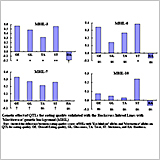 |
Agronomy & Crop Ecology
Performance of a Number of NERICA Cultivars in Zanzibar, Tanzania: Yield, Yield Components and Grain Quality
N. Sekiya, K.J. Khatib, S.M. Makame, M. Tomitaka, N. Oizumi and H. Araki
- NERICAs yielded higher than local cultivars under rainfed conditions.
- Erratic rainfall accounts for 37 to 73% of the yield variation.
- Spikelet number panicle-1 and % filled spikelets account for 70 to 90% of the yield variation.
- Grain qualities of NERICA 1 were evaluated as high.
- NERICA 1 should be promoted as being suitable for replacing existing cultivars in Tanzania.
Abstract Full Text PDF[666K] |
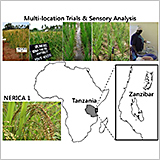 |
Temporal Growth Inhibition of Rice Plant and Growth Recovery Observed under Application of Anaerobically-Digested Cattle Manure
T. Nishikawa, K. Kido, K. Li, H. Inoue and T. Inamura
- We found a temporal growth inhibition of rice plants by application of anaerobically-digested manure.
- High application rates of the digested manure had small effects to aid initial growth of rice plants.
- Cultivars with longer growth period seemed favorable for rice production using the digested manure.
Abstract Full Text PDF[803K] |
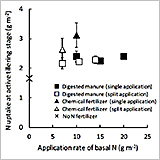 |
Effects of Applying Potassium, Zeolite and Vermiculite on the Radiocesium Uptake by Rice Plants Grown in Paddy Field Soils Collected from Fukushima Prefecture
S. Fujimura, K. Yoshioka, T. Saito, M. Sato, M. Sato, Y. Sakuma and Y. Muramatsu
- We examined several hypotheses that could potentially explain the enhancement of radiocesium levels in brown rice produced in paddy fields located in northern part of Fukushima Prefecture.
- The concentration of radiocesium in rice plants was decreased by applying potassium and by the addition of clay minerals such as zeolite and vermiculite, suggesting the low potassium content and the low sorption sites for Cs of the soils.
- Irrigation of radiocesium-enriched water produced by leaching contaminated leaf litter increased the radiocesium concentrations in rice plants.
Abstract Full Text PDF[491K] |
 |
Assessment of Potato Mother Tuber Vigour Using the Method of Accelerated Ageing
K. Rykaczewska
- The mode and intensity of sprouting of potato tubers are not unambiguous indicators of their vigour.
- The paper presents a method of accelerated ageing for assessment this trait of potato seed.
- The use of a 9-point scale allows characterization of potato cultivars in the same way.
Abstract Full Text PDF[1339K] |
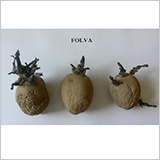 |
Effect of Stubble Shaving after High-Level Cutting on the Growth and Yield of Forage Sugarcane, KRFo93-1, under Multiple Ratooning Cultivation.
T. Sakaigaichi, Y. Terajima, T. Terauchi, T. Hattori, S. Ishikawa, I. Hattori, A. Sugimoto and M. Matsuoka
- Dry matter yield was higher in high-level cutting without stubble shaving (HC) than in Control with stubble shaving.
- The increase in the dry matter yield of HC was due to an enhancement of stem growth.
- The cultivation management without stubble shaving should be recommended in KRFo93-1.
Abstract Full Text PDF[2753K] |
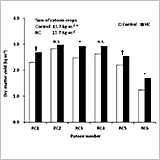 |
Influence of the Improved System of Rice Intensification (SRI) on Rice Yield, Yield Components and Tillering Characteristics under Different Rice Establishment Methods
S. Chen, X. Zheng, D. Wang, C. Xu and X. Zhang
- Planting methods alter SRI effect on rice yield.
- SRI did not work in tiller traits in direct seeding (DS) and seedling casting (SC).
Abstract Full Text PDF[569K] |
 |
Effects of Seed P-enrichment and Localized P-fertilizer Application on Soil-grown Wheat
N. Sekiya, R. Fukuju and K. Yano
- The localized P-application and seed P-enrichment increased dry matter to a similar extent, but their combination had no additive effect.
- The effect of localized P-application was observed earlier than that of seed-P enrichment.
- The growth variations were explained by P content, which depended on root length.
- Increasing root length may be the common feature of both methods and that either application alone may be sufficient to achieve this effect.
Abstract Full Text PDF[628K] |
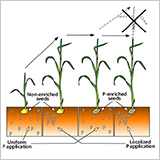 |












